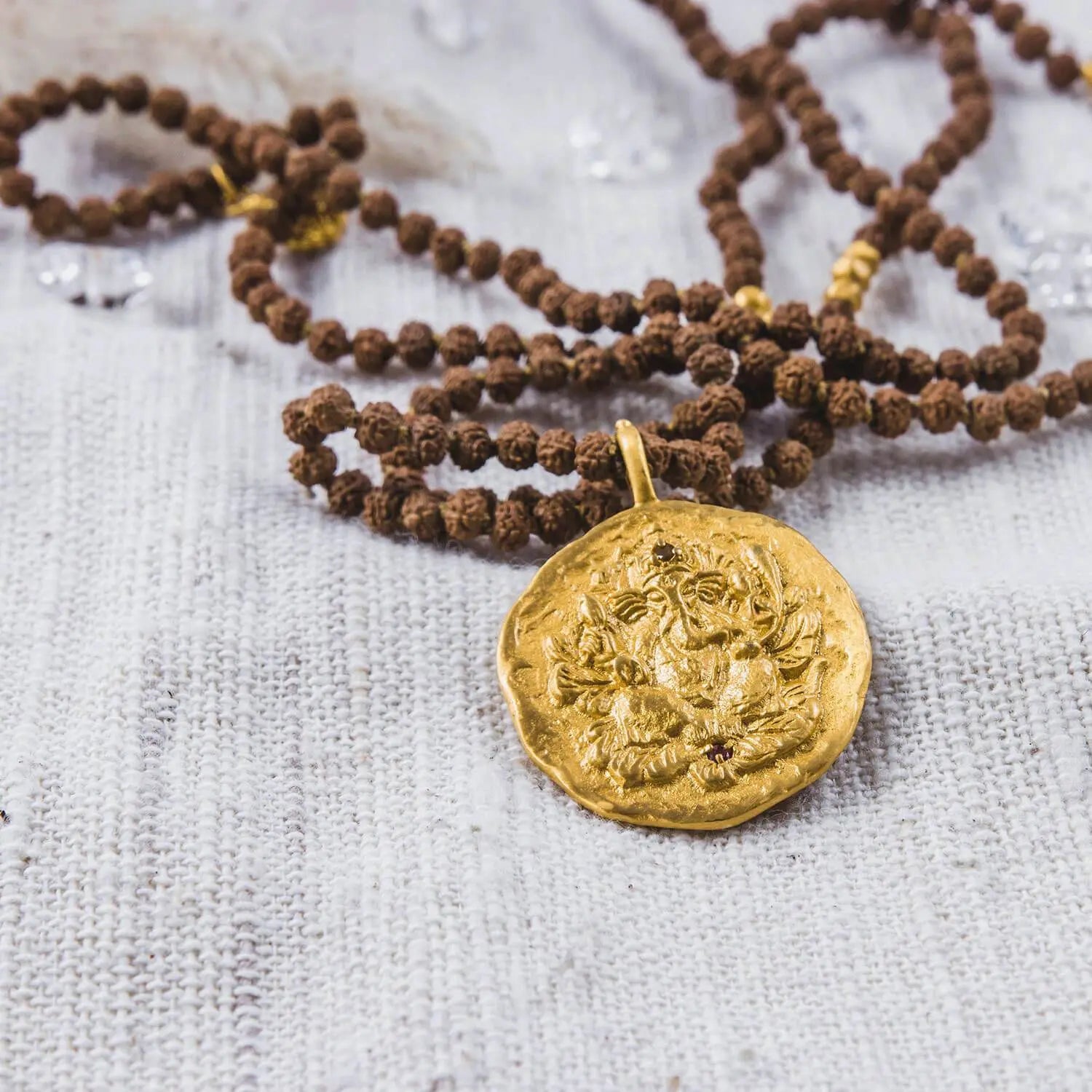
In the rich tapestry of Hindu mythology and spirituality, few figures are as beloved and widely revered as Lord Ganesha. With his distinctive elephant head, potbelly, and four arms, Ganesha holds a special place in the hearts of millions around the world. Beyond his charming appearance, this deity encapsulates profound symbolism, lessons, and values that continue to inspire and guide individuals on their spiritual journeys.
Who is Ganesha?
Lord Ganesha's origin story is deeply rooted in Hindu mythology. According to the most popular myth, Ganesha was created by Goddess Parvati from her own body. The story goes that Parvati sculpted a figure out of turmeric paste and brought it to life, setting the stage for Ganesha's unique appearance. His elephant head signifies wisdom, his large ears symbolize the ability to listen attentively, his broken tusk denotes sacrifice, and his potbelly exemplifies the idea of embracing all that life has to offer.
How did Ganesha get his Elephant head?
The story of how Lord Ganesha got his elephant head is a fascinating and symbolic tale in Hindu mythology.
Goddess Parvati, the wife of Lord Shiva, wished to create a son who would be her companion and protector when Shiva was away in meditation. To fulfill her desire, Parvati decided to create a child. She fashioned a boy from the turmeric paste and oils she used for her bath and brought the figure to life. Parvati instructed her newly created son, whom she named Ganesha, to stand guard at the entrance of her abode while she took a bath. She gave Ganesha strict orders not to allow anyone to enter the premises.
Meanwhile, Lord Shiva, who was away in deep meditation, returned to their abode. Unaware of Ganesha's existence and the orders given to him by Parvati, he attempted to enter. Ganesha, following his mother's orders diligently, blocked Shiva's path and denied him entry. A confrontation ensued between Shiva and Ganesha. In some versions of the story, Shiva's anger flared, and he severed Ganesha's head in a fit of rage, causing Parvati great sorrow.
In other versions, Shiva was more compassionate and only damaged Ganesha's head. Witnessing the grief of Parvati, Shiva realized the mistake and the importance of Ganesha. To make amends, he promised to give Ganesha a new life. The solution was to replace Ganesha's severed head with the head of the first living being that Shiva encountered, which happened to be an elephant. Ganesha was thus reborn with an elephant's head, becoming the unique deity that we know today.
The remover of obstacles
Ganesha is often referred to as the "Remover of Obstacles" and the "God of Beginnings," making him an essential figure in Hindu rituals and ceremonies. People invoke his blessings at the start of new endeavors, seeking his guidance to clear away obstacles that hinder their progress. Ganesha's association with wisdom is depicted through his large forehead, which is often adorned with a tilak, signifying the third eye and spiritual insight.
One of the most endearing aspects of Ganesha is his broken tusk. According to mythology, Ganesha broke his own tusk to write the great Indian epic, the Mahabharata, demonstrating the idea of sacrifice for a higher purpose. This characteristic teaches us the importance of adapting to change, embracing transformation, and utilizing our limitations to accomplish remarkable feats.
Ganesha's love for modaks (= sweet dumplings) and his mount, the mouse, are laden with symbolism. The modak symbolizes the sweet rewards of life that come after overcoming challenges. The mouse, often depicted at Ganesha's feet, signifies his ability to control even the smallest of desires, reminding us of the importance of self-control in the pursuit of spiritual growth.
Our Ganesha pieces
Since our early days we have been working with Ganesha, the keeper of deep wisdom.
Our Ganapati necklace and Hold my hand mala are pieces encoded with the energy of Ganapati, how Ganesha is often called, too.
All our pieces are blessed in a specific blessing ceremony before being sent out into the world. Ganesha plays an important role during these ceremonies and is revered and honoured frequently. Learn more about the ritual of our blessing ceremonies here.
How Ganesha can help you in your every day life
Ganesha is always a riot of colours. An affirmation of life. He is most often depicted in red and white, the colours being symbolic of passion and strength. If you’ve been to Bali before, you will notice that most house entrances have a Ganesha statue in front of them. As the remover and placer of obstacles it is commonly believed that Ganesha provides protection and blessings for every house, ensuring that obstacles are removed, and new endeavors are successful.
To work with Ganesha’s energy is a changer of life and life force all at once. To integrate the energy of Ganesha into our daily lives is a personal and spiritual journey. It's about cultivating qualities such as wisdom, adaptability, perseverance, and compassion in your life while seeking his guidance in times of need.
As the remover of obstacles I often like to chant to Ganesha when I am physically moving through heavy traffic (it works, I promise!), when I travel, when I need to ground myself and when I start new endeavours.

Practical ways of integrating Ganesha in one’s every day life can be this
Meditation and Visualization: Call in the energy of Ganesha at the beginning of your day to ground yourself into earth. Ganesha sits in our root chakra that is helpful when we desire to anchor deeper into ourselves. Begin your day with a short meditation or visualization exercise focused on Ganesha.
Ganesha Mantras: Chanting Ganesha mantras, such as the popular "Om Gam Ganapataye Namaha," can be a powerful way to invoke his energy. You can do this during your meditation practice or whenever you need to remove obstacles.
Ganesha Shrine: Create a small shrine or altar dedicated to Lord Ganesha in your home. Place a Ganesha statue or image, along with incense, candles, and fresh flowers. Offer prayers and gratitude to Ganesha regularly at this shrine.
Daily Reminders: Place a Ganesha figurine or picture on your desk, in your car, or in other places where you spend a lot of time. This serves as a constant reminder of Ganesha's energy and teachings.
Self-Reflection: Take time to self-reflect and identify areas in your life where you need to remove obstacles. This could involve decluttering your physical space, letting go of negative thought patterns, or addressing personal challenges.
Creativity and Innovation: Ganesha is associated with creativity and intellect. Channel his energy by engaging in creative pursuits, problem-solving, or brainstorming sessions.
Helping Others: Ganesha is also associated with compassion and helping others. Engage in acts of kindness and support those in need. By doing so, you align yourself with Ganesha's compassionate energy.
Celebrate Ganesha Chaturthi: If you're in a region where Ganesha Chaturthi is celebrated, participate in the festivities and rituals. It's an excellent way to immerse yourself in Ganesha's energy and teachings.
A celebration of Ganesha
Ganesha Chaturthi falls this year on September 13. is a significant Hindu festival that celebrates the birth of Lord Ganesh. The festival usually falls in the Hindu month of Bhadrapada, which typically corresponds to August or September in the Gregorian calendar. The festival usually falls in the Hindu month of Bhadrapada, which typically corresponds to August or September in the Gregorian calendar.
Ganesha Chaturthi is marked by elaborate rituals, ceremonies, and public celebrations.
Ganesha Chaturthi is a time of joy, devotion, and renewed beginnings. It exemplifies the spirit of seeking blessings for new ventures, overcoming challenges, and fostering a sense of unity among people.
Lord Ganesha's captivating persona extends far beyond his charming appearance. He serves as a profound reminder of the values and attributes that transcend time and cultural boundaries. Through his wisdom, adaptability, and the symbolism of his unique features, Ganesha offers guidance for navigating life's challenges and embracing personal transformation.
Om gam ganapataye namaha



